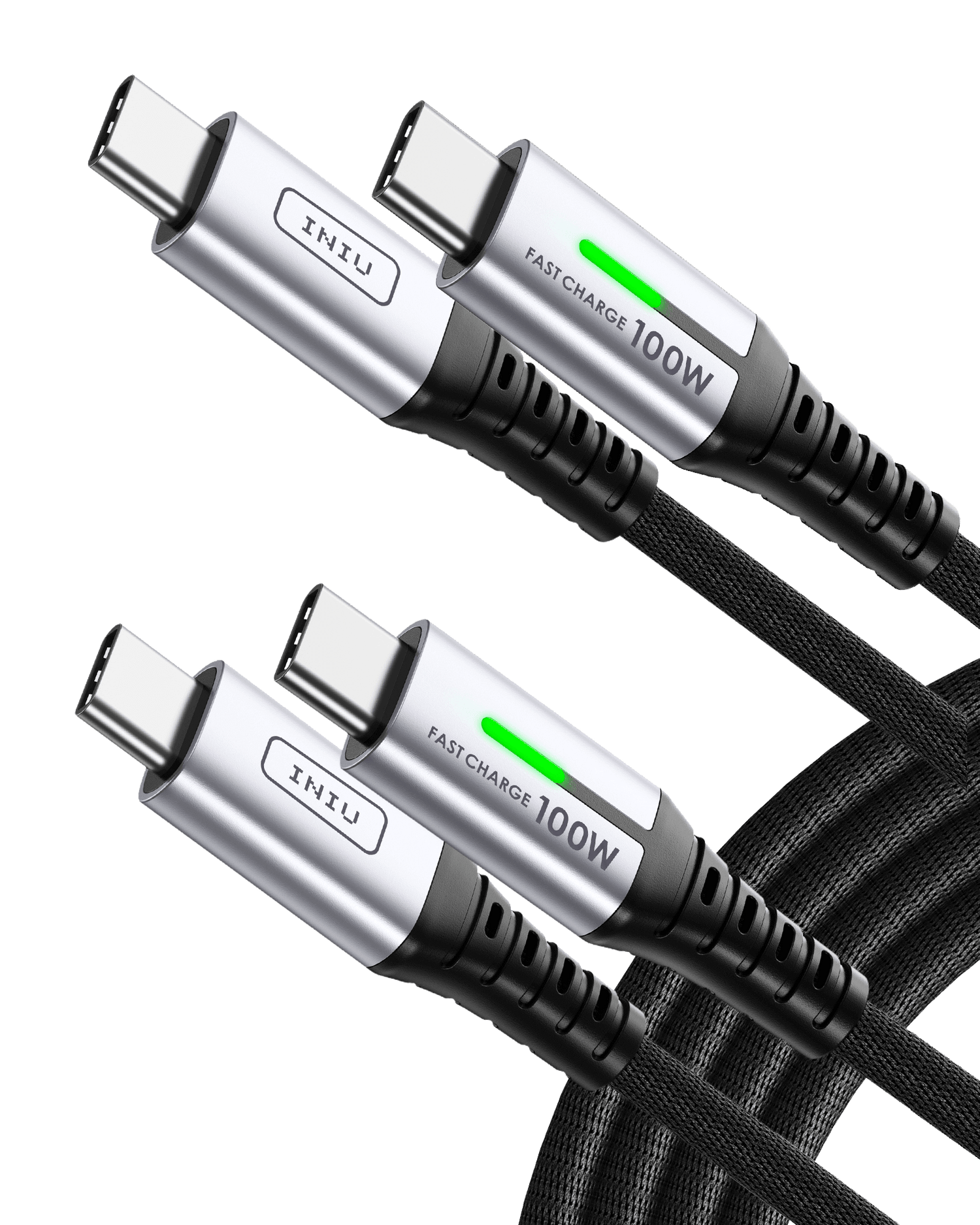
What Is GaN Charging Technology?
Our devices have become smarter and more powerful. Yet, their chargers often remain bulky and slow. Traditional power adapters can be inconvenient, getting hot and taking up valuable space on power strips. A new technology promises a better experience. Gallium Nitride, or GaN, is changing how we power our electronics.
GaN vs. Silicon: The Technology Behind the Change

Chargers perform a fundamental task. They convert high-voltage alternating current (AC) from a wall outlet into low-voltage direct current (DC) that your device can use. At the heart of this conversion process are transistors. These tiny electronic switches are made from semiconductor materials. For over 50 years, silicon (Si) has been the standard semiconductor for these components. However, silicon is approaching its physical limits, especially with the rising power demands of modern electronics.
Gallium Nitride (GaN) is a different kind of semiconductor material, often called a wide-bandgap semiconductor. It was first used in applications like LEDs and radar systems. Now, it is replacing silicon in power electronics because of its superior properties. GaN can handle higher voltages and temperatures than silicon. These characteristics allow for a fundamental redesign of power adapters.
The main difference is how well these materials use electricity. GaN has a bigger band gap than silicon. A material's band gap is the energy needed to make an electron conduct. GaN's band gap is about 3.4 eV, and silicon's is only 1.1 eV. A bigger band gap means the material can handle more electricity before failing. So, GaN parts can be smaller than silicon parts for the same voltage.
Also, another big advantage is switching frequency. The transistors in a charger turn on and off fast to change power. GaN transistors can switch faster, at several megahertz. Silicon transistors usually switch slower, at a few hundred kilohertz. Because of this faster switching, smaller parts like transformers can be used. These parts make up a lot of the size in old chargers. Because they are smaller, a GaN charger is small.
Lastly, GaN is better at changing power efficiently. A normal silicon charger might use 85-90% of the power, wasting 10-15% as heat. But GaN chargers can use more than 95%. Since less energy is wasted, less heat is made. This is important for safety and size.
| Property | Gallium Nitride (GaN) | Silicon (Si) | Implication for Chargers |
|---|---|---|---|
| Band Gap | ~3.4 eV | ~1.1 eV | Can handle higher voltages in a smaller physical space. |
| Critical Breakdown Voltage | ~3.5×106 V/cm | ~0.3×106 V/cm | Components can be smaller for the same power rating, increasing power density. |
| Typical Switching Frequency | Several Megahertz (MHz) | Few hundred Kilohertz (kHz) | Allows for smaller transformers and capacitors, leading to a more compact charger. |
| Typical Power Conversion Efficiency | >90%, up to 95%+ | ~85-90% | Less energy is wasted as heat, resulting in cooler operation and lower electricity use. |
| Maximum Operating Temperature | Can operate at higher temperatures | Lower temperature limit | Greater thermal stability and potential for a longer component lifespan. |

The 5 Key Benefits of Upgrading to a GaN Charger
Gallium Nitride works better in ways that are useful every day. GaN parts are special, so they make charging a lot better than older ways.
Smaller and Lighter (Enhanced Portability)
The most noticeable benefit is the reduction in size and weight. GaN has a much higher power density than silicon, which means it can handle more power in a smaller volume. A GaN charger can be up to 50% smaller than a silicon-based equivalent with the same power output. A 65W GaN adapter can be small enough to fit in a pocket, a feat impossible for a traditional 65W laptop brick. The compact design creates an excellent portable charger for travel, commuting, or simply reducing clutter at home.
Faster Charging Speeds
GaN technology enables a fast charger to operate at its full potential. While the GaN material itself does not dictate the charging speed, its ability to manage high power levels efficiently is crucial. It allows manufacturers to build high-wattage chargers (e.g., 65W, 100W, or even 200W) in a compact form factor. These chargers can then support modern fast-charging protocols like USB Power Delivery (PD) to rapidly power up compatible devices, from smartphones to laptops.
Improved Energy Efficiency
GaN chargers waste less electricity. With a power conversion efficiency often exceeding 95% (dependent on the charger design), more of the energy drawn from the wall outlet goes directly into your device's battery. Less energy is lost as waste heat. While the savings on an individual's electricity bill might be small, the cumulative effect is significant. Widespread adoption of GaN technology could reduce global consumer energy consumption and lower the associated carbon footprint.
Cooler and Safer Operation
The higher efficiency of GaN transistors means they generate less waste heat compared to silicon components at the same power level. Overheating is a common concern with traditional chargers, especially under heavy load. A cooler operating temperature not only improves safety but also reduces wear on the internal components, potentially leading to a longer lifespan for the charger.
Multi-Device Charging Capability
The combination of high power output and compact size allows many GaN chargers to feature multiple ports. A single GaN charger with several USB-C and USB-A ports can replace a handful of individual power bricks. It can simultaneously charge a laptop, a tablet, and a smartphone, all from one outlet. This capability is extremely convenient for users with multiple gadgets, decluttering workspaces, and travel bags.

Are There Any Downsides? An Honest Look at Cost and Compatibility
Even though GaN is better, it's not perfect. There are some things to think about before buying a new charger.
Higher Initial Cost
The most significant disadvantage is cost. GaN is a newer material that requires a more complex and expensive manufacturing process than silicon. For example, the synthesis of GaN crystals requires very high temperatures, over 1000°C. Silicon manufacturing, in contrast, has been refined for decades and is extremely cost-effective. As a result, a GaN charger is typically more expensive than a silicon charger of the same wattage. However, as the technology matures and production volumes increase, these costs are gradually decreasing.
Compatibility Nuances
A common point of confusion is the relationship between GaN and charging speed. The GaN material is hardware. Fast charging is enabled through software-based protocols like USB Power Delivery (PD), Programmable Power Supply (PPS), or Qualcomm Quick Charge (QC). A GaN charger will only fast-charge a device if both the charger and the device support the same protocol. If you connect an older device that does not support modern fast-charging standards, the GaN charger will simply default to a standard, slow charging speed, typically 5 volts. The charger is not "smarter" in a way that can force an old device to charge faster.
Potential for Overheating
While GaN components are more efficient and produce less waste heat per watt, the extreme miniaturization of high-power chargers presents a thermal challenge. A 100W charger packed into a tiny case has very little surface area to dissipate the heat it does generate. A well-designed charger from a reputable manufacturer will include sophisticated thermal management to operate safely. However, a low-quality or poorly designed charger can still become uncomfortably hot to the touch, which could affect performance and longevity.
Technological Immaturity and Reliability
Silicon has been the backbone of electronics for over half a century, with decades of refinement and reliability data. GaN technology, commercialized for chargers in the 2010s, is much newer. Some early models or chargers from less reputable sources have experienced durability issues or premature failure. This highlights the importance of choosing products from established brands that have invested in quality components and rigorous testing.
How to Choose Your First GaN Charger: 4 Steps
Picking the right GaN charger means more than just getting the smallest one. If you do it step by step, you can find a charger that is safe, works well, and is right for you.
Step 1. Assess Your Power Needs (Wattage)
The most important specification is the power output, measured in watts (W). The charger's wattage determines how quickly it can power your devices. You should choose a charger with a wattage that meets or exceeds the requirements of your most power-hungry device.
- Smartphones: A 22.5W to 45W charger is generally sufficient for fast-charging most modern smartphones.
- Tablets and Ultrabooks: These devices, like Macbook Air, typically require 45W to 65W for optimal charging.
-
Powerful Laptops: For high-performance or larger laptops, look for a charger with 100W or more. You can find your device's required wattage on its original charger or in its technical specifications. Using a charger with a higher wattage than needed is safe; your device's internal circuitry will only draw the power it is designed to handle.
Step 2. Count Your Devices (Ports)
Consider how many devices you need to charge at once.
- Single vs. Multiple Ports: If you only charge one device at a time, a single-port charger is fine. For charging a phone, laptop, and headphones simultaneously, a multi-port charger is essential.
- Port Types: Most new devices use USB-C, which supports fast charging. However, many accessories like smartwatches or older gadgets still use USB-A. A charger with a mix of USB-C and USB-A ports can offer greater versatility.
- Power Distribution: When multiple devices are plugged into a multi-port charger, the total wattage is split among the ports. Look for chargers with intelligent power distribution, which can allocate power efficiently based on the needs of each connected device. For example, a 100W charger might provide 65W to a laptop and 30W to a phone when both are connected.
Step 3. Match the Protocol
To unlock true fast-charging speeds, the charger must support the same protocol as your device.
- USB Power Delivery (PD): This is the universal standard for fast charging over USB-C and is used by most modern laptops, tablets, and smartphones.
- Programmable Power Supply (PPS): This is an extension of the USB-PD standard. It allows for small, incremental adjustments to voltage and current. Some modern smartphones require PPS for their fastest charging speeds. It can also help reduce heat buildup in the phone itself.
-
Qualcomm Quick Charge (QC): This is another common protocol, primarily used by Android devices with Qualcomm processors. Check your device's specifications to see which protocols it supports. A charger that supports multiple protocols offers the broadest compatibility.
Step 4. Prioritize Safety (Certifications)
Reputable chargers will have safety certifications, which indicate they have passed rigorous independent testing. Look for these marks on the product or its packaging:
- UL (Underwriters Laboratories). A globally recognized certification that confirms a product meets stringent safety standards for fire and electrical shock. It is particularly important for products sold in North America.
- FCC (Federal Communications Commission). A mandatory certification in the U.S. that regulates electromagnetic interference. It confirms the charger will not disrupt other wireless devices.
- CE (Conformité Européenne). A mark required for products sold within the European Union. It signifies compliance with the EU's health, safety, and environmental protection standards.
The presence of these certifications is a strong indicator of a well-built, reliable, and safe product.

Is a GaN Charger Worth It for You?
For the majority, the response is yes. A GaN charger is a vast upgrade over standard silicon technology. Numerous common issues will vanish due to the compact size and lightweight form and the strong, fast-charge functions.
If you travel frequently, lead a simple life, or have many devices to charge at once, the difference will show. Purchasing a quality GaN charger is worthwhile since it is effective and user-friendly. The investment in a quality GaN charger is justified by convenience and performance, especially when one compact adapter can replace three or four bulky ones.



